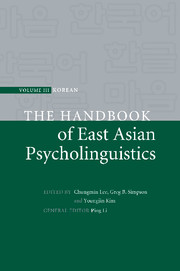Book contents
- Frontmatter
- Contents
- List of figures
- List of tables
- List of contributors
- Preface
- Introduction: Advances in Korean psycholinguistics
- Part I Language acquisition
- Part II Language processing
- 28 Visual processing of Hangul, the Korean script
- 29 English vowel spaces produced and perceived by Americans and Koreans
- 30 Morphological representation and processing of Sino-Korean words
- 31 The role of phonology in word recognition of Korean Hangul and Hanja
- 32 Lexical and sublexical processes in Korean word recognition
- 33 Prosody in sentence processing
- 34 Korean sentence processing
- 35 Sentence processing and memory representation in Korean
- 36 Understanding complex sentences: memory constraints and informational structure
- 37 ERP studies of Korean language processing: word-order effects
- 38 Inferences during discourse comprehension in Korean
- 39 Morpho-syntactic processing in Korean aphasics
- 40 Morpho-syntactic processing of Korean-speaking adults with Broca's aphasia
- 41 Comprehension deficits in Korean agrammatic aphasia
- 42 Developmental reading disorders in Korean
- 43 Individual differences in Korean language processing: context-dependent processing of skilled readers in word ambiguity resolution
- 44 A computational model of lexical and morphological processing in Korean
- References
- Name index
- Subject index
32 - Lexical and sublexical processes in Korean word recognition
from Part II - Language processing
Published online by Cambridge University Press: 05 June 2012
- Frontmatter
- Contents
- List of figures
- List of tables
- List of contributors
- Preface
- Introduction: Advances in Korean psycholinguistics
- Part I Language acquisition
- Part II Language processing
- 28 Visual processing of Hangul, the Korean script
- 29 English vowel spaces produced and perceived by Americans and Koreans
- 30 Morphological representation and processing of Sino-Korean words
- 31 The role of phonology in word recognition of Korean Hangul and Hanja
- 32 Lexical and sublexical processes in Korean word recognition
- 33 Prosody in sentence processing
- 34 Korean sentence processing
- 35 Sentence processing and memory representation in Korean
- 36 Understanding complex sentences: memory constraints and informational structure
- 37 ERP studies of Korean language processing: word-order effects
- 38 Inferences during discourse comprehension in Korean
- 39 Morpho-syntactic processing in Korean aphasics
- 40 Morpho-syntactic processing of Korean-speaking adults with Broca's aphasia
- 41 Comprehension deficits in Korean agrammatic aphasia
- 42 Developmental reading disorders in Korean
- 43 Individual differences in Korean language processing: context-dependent processing of skilled readers in word ambiguity resolution
- 44 A computational model of lexical and morphological processing in Korean
- References
- Name index
- Subject index
Summary
The purpose of writing is to represent speech. In writing, a unit of print represents a unit of the speech stream. Writing systems differ, however, in how they define ‘unit of the speech stream’ for the purpose of writing. In a logography such as Chinese, the unit of speech represented by a character is the morpheme. A syllabary, such as the Kana scripts of Japanese, represents each syllable with a single character. A large majority of the world's languages today use an alphabetic system, in which each character (or combination of characters) represents a single phoneme.
Alphabetic systems also vary in the consistency of the mapping between print and sound. In ‘shallow’ orthographies (such as Spanish, Italian, or, in the present case, Korean), there is close correspondence between written characters and the phonemes they represent. In a ‘deep’ orthography such as English, this correspondence is compromised. For example, the letter c may be pronounced either as /k/, as in cat, or /s/, as in circle. A number of studies have examined the degree to which a reader's knowledge of the sound system affects the processing of printed words. Because of the many inconsistencies found in English in the relation between spelling and pronunciation, it is perhaps not surprising that it has been the focus of so much of the research in this area.
Much of this research has investigated issues concerned with word regularity.
- Type
- Chapter
- Information
- The Handbook of East Asian Psycholinguistics , pp. 418 - 422Publisher: Cambridge University PressPrint publication year: 2009

